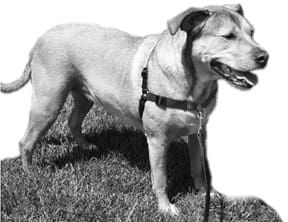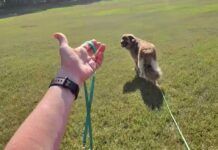by Pat Miller
Many dogs pull on leash so much and so hard that it can be difficult, even dangerous, to take them for walks. Frustrated owners often stop trying to exercise and socialize their pullers, leaving the dogs bored, lonely, and underexercised in backyards. This can result in the development of undesirable behaviors – barking, digging and chewing, perhaps roaming – to alleviate boredom and expend energy. Adolescent, out-of-control, digging, barking, and chewing dogs frequently end up rehomed or surrendered to animal shelters.
This is unfortunate, as most dogs can be trained to walk on leash without pulling. I have discussed this process in feature articles (such as “Loosen Up!,” in the November 2000 issue of WDJ) and reviews of no-pull products (such as “No Miracle Products,” April 2001, and “A New SENSE-ation,” October 2003).

The training process can require a lot of dedication and patience, however, and not everyone is up to the task. This is where pet product manufacturers step in, marketing a wide variety of training tools purported to stop problem pulling practically overnight.
Unfortunately, some of the products are quite painful and aversive for the dogs, defeating the big-picture goal of building a harmonious, enjoyable relationship with your dog. (And that’s if the products work as advertised; many don’t work at all.)
All of this explains why I was delighted to discover head halters, also referred to as headcollars, in 1995.
A halter fits snugly on the dog’s head, offering an attachment point for the leash (under the dog’s chin) that is far forward from the site where collars or harnesses attach. Even large or strong dogs can’t pull hard from their heads; they don’t have the strength in their necks.
Also, the leverage afforded by this attachment site for the leash enables the handler to turn the dog’s head toward her – away from whatever the dog is pulling toward – giving her the opportunity to mark the behavior with a click! or a “Yes!” and give the dog a treat to reinforce loose-leash behavior, actually furthering the training (not just management) process. Finally! A training tool that could help an owner gently prevent a dog from pulling on leash, without causing any physical pain!
I did find that a few dogs strenuously objected to wearing halters, and required lots of counter-conditioning and desensitization before they would tolerate wearing one. When I wrote my first article about halters for WDJ (in July 1998, when they were relatively new), my overall assessment was, “Although some high-strung dogs never learn to tolerate wearing something on their head and face, and some need a period of adjustment before they accept them, headcollars are the most effective and humane no-pull aid for most dogs.”
With experience, reservations
After I learned about halters, I started using them occasionally with clients’ dogs when appropriate, with considerable success. As I continued to use them, however, I began to notice some significant disadvantages, which, in many cases, appeared to outweigh the potential benefit of the halter.
I was not alone. Some of my training colleagues were beginning to voice concerns as well. In the June 2000 issue of WDJ, I wrote about halters again, this time listing concerns about halters shared by members of the Association of Pet Dog Trainers e-mail list, including:
• Some dogs hate them
• Head halters can come off
• The halters can be difficult to put on
• It can be difficult to fit the halters properly; some dogs are very difficult to fit
• Halters look like a muzzle, prompting some passersby to regard your dog with fear or suspicion
• Halter straps can rub (but can be covered with fleece to prevent this)
• There is potential for spinal injury if the collar is used improperly
In the same article, I reiterated my support for the training tool, but put more emphasis on my reservations. I wrote, “The head halter is the perfect tool for the right applications, but it’s not the easy answer to every dog’s leash walking needs.”
Four years later
All of these concerns are still valid four years later, along with an additional one that has been growing in my mind and experience. Many, if not most, dogs who wear head halters appear depressed, at least to a degree, even if they are not actively trying to remove the halter. While this is a price that many people will gladly pay for the increased ease of walking their dogs, it’s not one I feel comfortable advocating, especially since for the last decade I’ve made “positive” training the focus of my career.
It’s important to remember that when we talk about positive training methods and tools, the perception needs to be that of the dog, not the human. Just because head halters seem far more humane to us than choke, pinch, or shock collars, it doesn’t necessarily make them more positive for the dog.
I have used a head halter with Dubhy, my Scottie, to manage and modify his aggression toward other dogs. Although he tolerates it reasonably well, he tries to rub it off on every occasion that he wears it, and his demeanor is subdued, although I wouldn’t go so far as to call it depressed. He clearly finds wearing the head halter irritating at best, perhaps even aversive.
Since one of the prime goals of counter-conditioning and desensitization (CC&D) to modify aggression is to reduce stress – stress being a major factor of aggression – it would seem a contradiction to use an aversive training/management tool that induces stress in the dog!
So where does that leave dog owners in search of a gentle, positive training tool to teach polite leash manners and manage aggressive behavior? It’s a quandary!
Ahead of the game
Fortunately, an even newer product offers a viable alternative to those who are seeking a tool to help minimize pulling on leash. I reviewed the original front-clip control harness (the SENSE-ation harness) in the October 2003 issue; now there are three different brands on the market. These tools help control the strong-pulling dog while avoiding many of the negatives of the head halter. Comparing them, I found:
• Most dogs accept them immediately, without any resistance
• It is difficult (but not impossible) for a dog to remove a harness
• The harnesses are easier to put on
• It does take some fiddling, sometimes a lot of fiddling, to fit the harnesses. As with head halters, some dogs can be more difficult to fit
• The harnesses look like – harnesses. There is no negative public perception of dogs wearing harnesses
• Harness straps can also rub (and can be covered with fleece) but rub less than halters
• Potential for injury with a harness is very slight to nonexistent
The front-clip control harness closely resembles an everyday harness. It has one strap that goes over the shoulders, one that goes under the barrel behind the front legs, and one that goes across the front of the chest. The harness slips easily over the dog’s head; it’s not necessary to have him step through any of the straps. In the middle of the front chest strap there is a ring for attaching the leash. For added security and to reduce “gapping” in the front straps, you can attach the leash to the collar ring as well.
When the dog pulls, the tension on the front chest ring turns the dog back to the handler, providing an opportunity for the trainer to reinforce desirable behavior (not pulling). Most dogs accept the harness immediately, and are much more manageable on leash with surprising speed. Short-legged dogs can sometimes step out of them, but if the leash is clipped to the collar as well, the likelihood of this is reduced, and if it happens, the dog is still restrained by the leash.
There are now three brands of front-clip control harnesses on the market. Despite a few differences in features, there appears to be very little difference in the products’ effectiveness. I have used and like them all.
• The SENSE-ation Harness, produced by Softouch Concepts of Union City, CA (866-305-6145; www.softouchconcepts.com). Softouch is the originator of the front-clip control concept. The SENSE-ation is made of nylon with nickel rings and plastic hardware. Each harness is a solid color and is available in five sizes for $21-$26. Softouch also makes an economy model, the SENSE-ible Harness. It comes in six sizes for $16 – $21.
• The K9 Freedom Harness, made by Wayne Hightower of Los Angeles (800-246-6336; www.waynehightower.com). It comes in five sizes, for $21 – $26. Also made of nylon, the Freedom Harness uses a different color for each of the three straps, making it easier to remember which way it goes on the dog.
• The Easy Walk Harness, produced by Premier Pet Products of Richmond, VA (800-933-5595; www.gentleleader.com). Available from trainers and vets, who can order them (Premier does not sell directly to consumers). Comes in five sizes for $25. Premier crafts its harness in two different colors, making it easy to put it on right-side-up. They also added a martingale loop in the front strap to help reduce gapping, which has proved to be a problem with some dogs.
I now routinely use these harnesses in order to facilitate training with pulling dogs who aren’t responding well to positive reinforcement for loose-leash walking and rarely, if ever, recommend a head halter simply for pulling behavior.
Still great for aggression cases
While I use head halters much less than in the past, there are still occasions when I find them useful, worth the effort and potential negative fallout. One is when a dog is prone to using his teeth inappropriately, either in serious outward-directed aggression or out-of-control mouthiness directed toward the handler. The head halter is a great tool for preventing bites to others.
In a perfect CC&D program, the dog is never introduced to the stimulus that triggers his arousal at an intensity great enough to cause a strong emotional response; the best way to reduce the intensity of the stimulus is to keep it at a greater physical distance, at least in the early stages.
Since, with aggression, the stimulus is usually a person or another dog, and because in real life, it’s impossible to keep all other people and dogs at a distance, I suggest using a halter. This gives you a high degree of control over your dog’s head, enabling you to make an emergency escape on those occasions when an unleashed dog or toddler charges up to your dog unexpectedly. It’s important, however, to complete a thorough desensitization program to the halter, and to make sure the dog is not unduly stressed by wearing it.
If your dog is simply too stressed by or won’t tolerate the head halter, a muzzle, with the leash attached to the dog’s regular collar, is a second option. Some dogs are less bothered by a muzzle, since it doesn’t put varying degrees of pressure on the nose as leash tension changes. A dog with aggression issues should be comfortable wearing a muzzle anyway, for those necessary vet visits and other times when the risk of a bite might be high. Use the desensitization process described below to acclimate your dog to a muzzle. The combination of a muzzle and front-clip control harness can give you nearly the same degree of safety and control as the head halter.
Another perfect candidate
A dog who nips and bites at his owner while walking on leash is an annoyance at best. At worst, the behavior can become dangerous, resulting in aroused bites that break skin and lead to a loss of control and damage to the relationship. In this case, the subduing effect of a halter can be useful, at least initially, to dampen the dog’s enthusiasm for aroused leash-play. Plus, the halter enables the owner to direct the dog’s mouth away from human body parts and clothing to manage the inappropriate behavior.
This is especially important with aroused leash-play-biting because other attempts to verbally or physically redirect the behavior can inadvertently reinforce the undesirable behavior; the dog sees it as the owner’s participation in the game. Even harsh verbal or physical corrections (which I don’t recommend anyway) can result in increased arousal from the dog. The halter can provide an opportunity that a harness cannot, to manage the inappropriate behavior while reinforcing desirable leash behaviors, until the halter is no longer necessary.
So, yes, we still reserve a space in our training toolbox for the halter, just not as much space as we did a few years ago, thanks to more recent developments in tools and techniques that foster positive relationships with our canine companions.
-Pat Miller, CPDT, is WDJ’s Training Editor. She is also author of The Power of Positive Dog Training, and Positive Perspectives: Love Your Dog, Train Your Dog.






